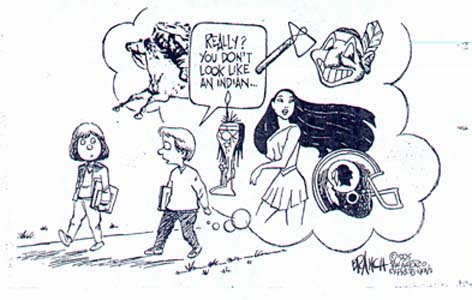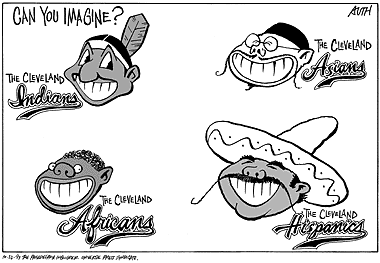Exhibition and Karl Ströher Prize for French Artist Cyprien Gaillard
“The window panes have arrived as ‘spoils’ in Frankfurt. The term ‘spoil’ originally referred to the hide of an animal or the enemy’s armor and was later extended to apply to old fragments of architecture. The Native American grinning through the shimmering glass brings to mind the constant change in power relations, hierarchies and values. The two construction sites, the one in Frankfurt and the other in Berlin, are prime architectural examples of this,” relates Klaus Görner, the curator of the exhibition.

Indian Palace by Cyprien Gaillard.
Why is this Indian Smiling—in Berlin?
The statement reads, in part: “Gaillard’s frequent use of the logo in his work points at the paradox of US sports club’s adoption of American Indian team names and mascots, irrespective of the country’s destruction of its indigenous peoples. Gaillard is interested in how such ancient symbols live on in marketing and mass culture, how what is ‘out of time’ continues to exist.”
Another piece by Gaillard, “Indian Palace,” features the Indians mascot silkscreened on windows from the East Berlin Palast der Republik, which was demolished in 2009. A curator of an exhibition that featured the work offered this explanation “The Native American grinning through the shimmering glass brings to mind the constant change in power relations, hierarchies and values.”
It’s no coincidence that the pieces work with demolished or likely-to-be demolished buildings; Gaillard’s explanations of both pieces also include the idea that the Indian is a symbol of Cleveland, which is a symbol of urban decline or the futility of urban planning—in piece called “Contemporary Art and Economics in Berlin,” a writer from the Wall Street Journal tries to make that idea fly.
But Rob Schmidt of Newspaper Rock isn’t buying it, or any of Gaillard’s reasoning, really.
First, consider curator Klaus Görner's statement that Chief Wahoo "brings to mind the constant change in power relations, hierarchies and values." Really? Putting Chief Wahoo in a window or on a building does all that?
The change in power relations between whom and whom? The US government and American Indians? The German government and German citizens? The German capitalists who constructed the building and the German motorists who drive past it? Or...?
Are these motorists are supposed to understand the "change in power relations, hierarchies and values" by glancing at Chief Wahoo on a building for three seconds? Yeah, I'm sure they spent hours pondering the significance of that juxtaposition. Not.
If this were a Chief Wahoo sign in downtown Cleveland, would it bring to mind the same "change in power relations, hierarchies and values"? Or would it just be a logo advertising a baseball team? How does moving it to Germany change it from a racist stereotype into art?
Gaillard's bogus explanation
Next consider Gaillard's interest in "ancient symbols [that] live on in marketing and mass culture." For starters, the Chief Wahoo logo isn't ancient; it's only about a century old. More important, Gaillard could say the same about any of a million stereotypical Indian symbols. So they live on...so what? Does that negate their stereotypical harm? Does it make them art?
Gaillard hasn't done anything artistic with Chief Wahoo such as colorizing him a la Andy Warhol. He's simply put Chief Wahoo in odd locations--e.g., in a window or on a building. I guess we're supposed to assume this is an ironic statement. Something along the lines of: "Look, the US mistreated Indians! The Cleveland baseball team stereotyped Indians! And it's still going on!"
But every halfway intelligent person already knows this. And Gaillard's Wahoo art doesn't provide any new insight to viewers. He's simply repeating the racist stereotype and calling it art.
I'd say this art is a good example of hipster racism:
Readers of Newspaper Rock have seen this kind of fallacious "thinking" thousands of times. For instance, when a hipster in a headdress says he's being ironic or making fun of racists. When a bigot tells an insulting joke but says it was meant to be funny or satirical, not racist. When buffoons like the Dudesons mock Indians but say they were mocking the people who mock Indians. And when sports teams use offensive mascots but say they're "honoring" Indians.
All these excuses fail because the images themselves are racist. Putting a label on an image saying "This isn't racist, it's art (or a joke, or an honor)" doesn't affect the image itself. If it was racist before, it's still racist.
The only time a racist image isn't racist is when someone uses it to make a clearly critical statement about race. Unlike Gaillard's art, for instance, the following are commentaries on America's attitude toward Indians:


These aren't profound works of art. But they give you more than just a standard Chief Wahoo for you to interpret. People don't need to wrack their brains for a tortured explanation of how a racist image isn't racist. It doesn't take much thought to conclude: "Yes, these are critiques of Chief Wahoo, not endorsements of him."
Finally, note that Gaillard's explanation is at variance with Görner's. One of them doesn't seem to know what he's talking about. Maybe they both don't.
Back to the original question
Gaillard has intentionally juxtaposed Chief Wahoo with decrepit or demolished East Germany buildings. Why? If he were making some statement about Chief Wahoo or Indians, he wouldn't need this juxtaposition. He could put Chief Wahoo in a park, on a highway, or in a shiny new building.
Perhaps Gaillard doesn't understand his own art...but I do. Germans consider East Germany a backward, inferior place compared to West Germany. The broken-down buildings exemplify that. Gaillard has used the savage Chief Wahoo to symbolize this physical and cultural decay. In short: Indians = primitive/fallen/absent civilization = East Germany.
For more on the subject, see "Jokes" Without Punchlines Are Racist, Comedian Isn't Afraid to Be Racist, and The Last Acceptable Racism.

No comments:
Post a Comment